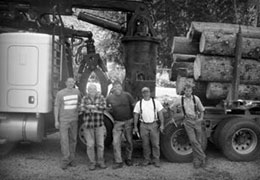Leyland Cypress Trees
Points of Interest
-
Professional Chipping The smallest or largest jobs
-
Our Services Able Tree Service, inc.
-
Zip Lining Safely removing the top
From the Gallery


Leyland Cypress Trees
The Leyland cypress - often referred to simply as leylandii, is a fast-growing coniferous evergreen tree much used in horticulture, primarily for hedges and screens. Even on sites of relatively poor culture, plants have been known to grow to heights of 15 metres (49 ft) in 16 years. Their rapid, thick growth means they are sometimes used to enforce privacy.
Leyland cypress is light-demanding but is tolerant of high levels of pollution and salt spray. A hardy, fast-growing natural hybrid, it thrives on a variety of soils and sites and are commonly planted in gardens to provide a quick boundary or shelter hedge, because of their rapid growth. Although widely used for screening, it has not been planted much for forestry purposes. In both forms of the hybrid, Leyland cypress combines the hardiness of the Nootka or Alaska cypress with the fast growth of the Monterey cypress.
The tallest Leyland cypress presently documented is about 40 metres (130 ft) tall and still growing. However, because their roots are relatively shallow, large leylandii tend to topple over. The shallow root structure also means that it is poorly adapted to areas with hot summers, such as the southern half of the United States. In these areas it is prone to develop cypress canker disease, which is caused by the fungus Seiridium cardinale. Canker causes extensive dieback and ultimately kills the tree. In California's Central Valley, they rarely live more than ten years before succumbing, and not much longer in southern states like Alabama. In these areas, the canker-resistant Arizona cypress is much more successful. In Northern areas where heavy snows occur, this plant is also susceptible to broken branches and uprooting in wet, heavy snow. The sap can cause skin irritation in susceptible individuals.
Leyland Cypress Trees - A Short History
In 1845, the Leighton Hall, Powys estate was purchased by the Liverpool banker Christopher Leyland. In 1847, he gave it to his nephew John Naylor (1813–1889). Naylor commissioned Edward Kemp to lay out the gardens, which included redwoods, monkey puzzle trees and two North American species of conifers in close proximity to each other – Monterey cypress and Nootka cypress. The two parent species would not likely cross in the wild as their natural ranges are more than 400 miles (640 km) apart, but in 1888 the hybrid cross occurred when the female flowers or cones of Nootka cypress were fertilised by pollen from Monterey cypress.
John Naylor's eldest son Christopher John (1849–1926) inherited Leighton Hall from his father in 1889. Christopher was a sea captain by trade. In 1891 he inherited the Leyland Entailed Estates established under the will of his great-great-uncle, which passed to him following the death of his uncle Thomas Leyland. On receiving the inheritance Christopher changed his surname to Leyland, and moved to Haggerston Castle, Northumberland. This examines Charles Leyland's connections with the sea and Northumberland. He further developed the hybrid at his new home, and hence named the first clone variant 'Haggerston Grey'. His younger brother John (1856–1906) resultantly inherited Leighton Hall, and when in 1911 the reverse hybrid of the cones of the Monterey cypress were fertilised with pollen from the Nootka, that hybrid was baptised 'Leighton Green.'
The hybrid has since arisen on nearly 20 separate occasions, always by open pollination, showing the two species are readily compatible and closely related. As a hybrid, Leyland cypress is sterile, so all the trees we now see have resulted from cuttings originating from those few plants. There are over forty forms of Leyland cypress, and as well as 'Haggerston Grey' and 'Leighton Green', other well-known forms include 'Stapehill', which was discovered in 1940 in a garden in Ferndown, Dorset by M. Barthelemy and 'Castlewellan', which originated from a single mutant tree in the Castlewellan estate arboretum in Northern Ireland. This form, widely propagated from the 1970s, was selected by the park director, John Keown, and was named Cupressus macrocarpa 'Keownii', 1963.
"With Able Tree Service, Inc. and the owner's third generation experience you are guaranteed peace of mind."
Call us today at 360-403-9532 for all of your tree service, pruning, and stump grinding needs.












